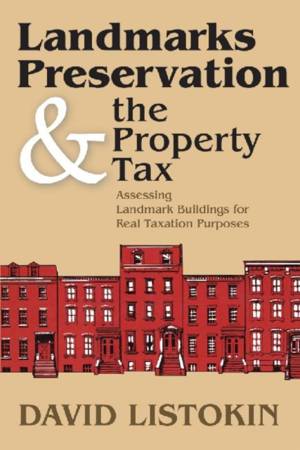
- Afhalen na 1 uur in een winkel met voorraad
- Gratis thuislevering in België vanaf € 30
- Ruim aanbod met 7 miljoen producten
- Afhalen na 1 uur in een winkel met voorraad
- Gratis thuislevering in België vanaf € 30
- Ruim aanbod met 7 miljoen producten
Zoeken
Landmarks Preservation and the Property Tax
Assessing Landmark Buildings for Real Taxation Purposes
David Listokin
€ 94,95
+ 189 punten
Uitvoering
Omschrijving
Historic preservation is an issue of growing importance and public commitment. Federal and state mechanisms have been established to identify and support historic buildings/sites, while local governments have been active in supporting and protecting historic resources. Communities across the country have established designation programs whereby individual buildings or districts of historical-architectural significance are accorded landmark status. Designation activity has been accompanied by growing interest in other local incentives/disincentives to the support of historic buildings. In this regard, the property tax is viewed as either a possible powerful drawback to or a catalyst of preservation. This study examines the relationship between historic preservation and the property tax, focusing on the question of how designated buildings should be assessed for real taxation purposes. Listokin focuses on New York City in considering the effects of historic status on property value and in evaluating assessment practices. But this book's findings are transferrable to other communities because the base conditions are similar. Many other cities have designation programs modeled on New York City's. In addition, New York's property-tax system and administrative processes resemble those found in communities across the nation. To enhance the transferability of this study's findings, Listokin refers to the national experience and literature, typically on a side-by-side basis with the New York City counterpart.
Specificaties
Betrokkenen
- Auteur(s):
- Uitgeverij:
Inhoud
- Aantal bladzijden:
- 255
- Taal:
- Engels
- Reeks:
Eigenschappen
- Productcode (EAN):
- 9781412848572
- Verschijningsdatum:
- 15/07/2012
- Uitvoering:
- Paperback
- Formaat:
- Trade paperback (VS)
- Afmetingen:
- 152 mm x 229 mm
- Gewicht:
- 344 g

Alleen bij Standaard Boekhandel
+ 189 punten op je klantenkaart van Standaard Boekhandel
Beoordelingen
We publiceren alleen reviews die voldoen aan de voorwaarden voor reviews. Bekijk onze voorwaarden voor reviews.








